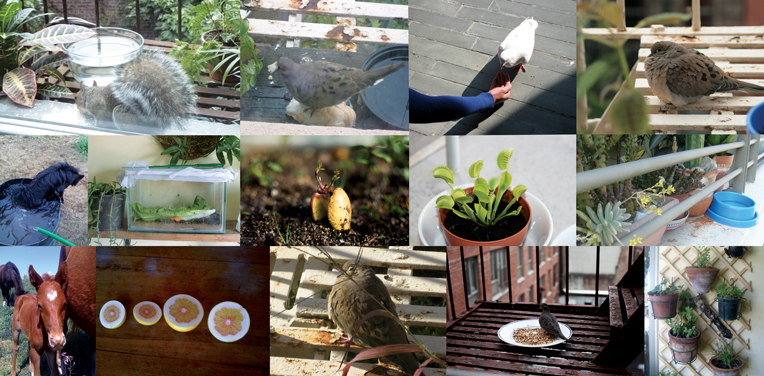INVOLUNTARY GREEN SPHERES / HOSTING WILD SPECIES
It is a collaborative project that attempts to host wild animals that inhabit the ecosystem in which our homes are located and be able to somehow mitigate the negative effects produced by cities in the degradation of the environmental systems.
It consists in the creation of a network of small-scale ecosystems with the necessary conditions to attract wildlife. This transforms the available green areas (gardens, terraces, balconies, plazas, sidewalks and windows). The objective is to go adding up these self sufficient islands to a territory or "green corridor" to a block, neighborhood or country level, establishing by this a map through the interrelationship and creation of personal green spheres. Following with the network conception of Peter Sloterdijk, these green spheres are interconnected through the species that inhabit them. Through this they form a growing network of mini ecosystems that intertwine our urban life system.
In India, I was surprised with the close relationship between animal species and human beings (we are animals, after all). In response to their spiritual vision, instead of throwing away the left over food, these are offered to animals, which materialize into their gods. The result: hundreds of birds and animal species surrounding their houses and bushes, achieving proactive and harmonious relations amongst them. Another example, cows are fed mainly by human garbage. They also extract milk from these, even if it is scarce. In the western world, personal green spheres are being organized through projects such as National Wildlife Federation's Backyard Project in Canada or Animal States of Fritz Haeg, in California. These projects work as larger spheres which contribute and form a map of ecosystems to a world wide level.
PERSONAL EXPERIENCES
After a long and failed history of pets, the garden in my house turned into a cemetery for tropical birds, fish, rabbits, cats, doves, turtles and iguanas. It was a place suitable for urban naturalism but not to promote real conservation of species. This situation made me recognize that the most logical thing would be to shelter the animals that live naturally in the habitat, rather than force species to adapt to geographical/climatic situations which do not correspond to them
My grandparents have embraced a population of finches for years in Bahía Salado, Chile ever since they saw a couple nested in the semi-opened roof of their house. After 20 years of providing water and food daily, they have come to have 500 individuals in that area. They have only nestled in the cliff where there are trees to sleep and nest in. In the surroundings such as Maldonado and Pajonal no examples like those have been seen. This means that their habitat is the house and its surroundings.
My first attempt to host wildlife was in Santiago, Chile when I occupied a communal terrace with various species of plants, water, herbs and food for birds with my sisters. This later served for the botanical study project of weeds “Understanding my space as a natural system” in 2008. Our first visitor didn’t take long to arrive. A white dove stayed for several months. Now, with the geographical change to a new habitat, I have enabled an emergency ladder of the apartment in New York, creating a small system that provides the aerial visitors with food, water, shelter and certain plants.
In this experiment, I have managed to attract three species of birds that come to feed. The doves have the monopoly. It is a process in constant renewal. The nesting box is still empty and I have discovered through failed actions which species of plants I can grow in a confined space and in this specific climate. I continually put the species on trial to see their behavior. For example, by expanding the size of one of their wells I was able to encourage new actions and some birds come to bathe. This green personal sphere gives way to investigation through personal experience situations of adaptation, competition between the species and mutualism among others. This leads to a deeper understanding of the ecosystem where we live in and at the same time helps to connect animal populations affected by human activities.

|